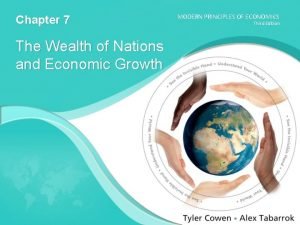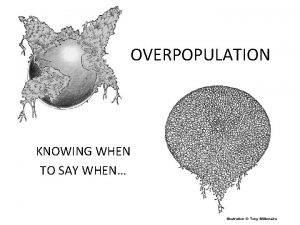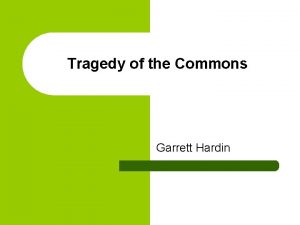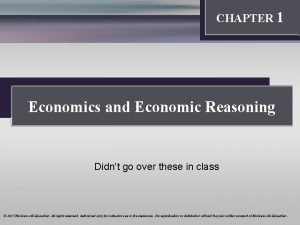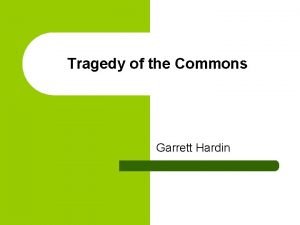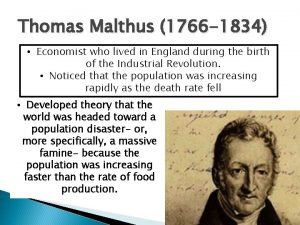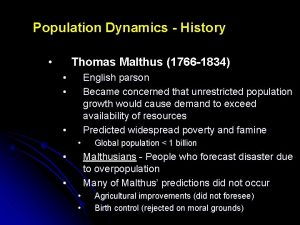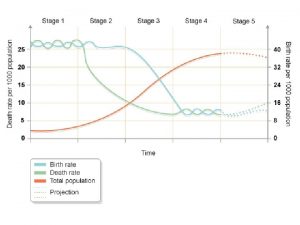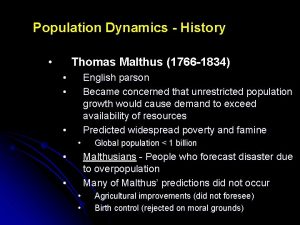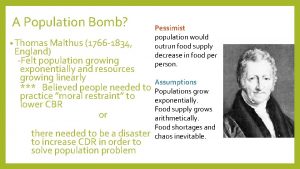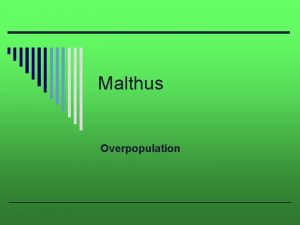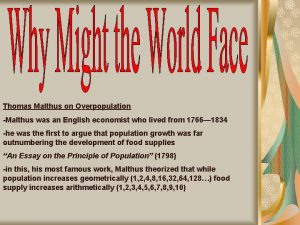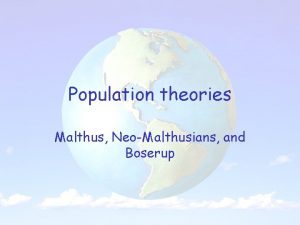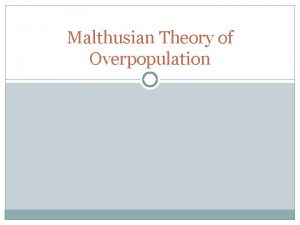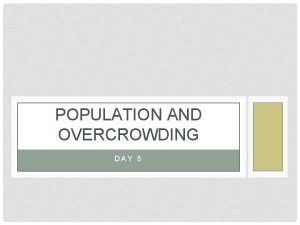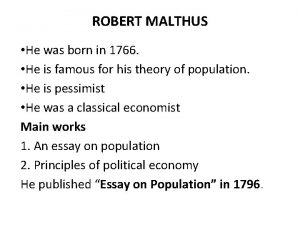HANS ROSLING Thomas Malthus 1766 1834 Economist who




























- Slides: 28

HANS ROSLING

Thomas Malthus (1766 -1834) • Economist who lived in England during the birth of the Industrial Revolution. • Noticed that the population was increasing rapidly as the death rate fell • Developed theory that the world was headed toward a population disaster- or, more specifically, a massive famine- because the population was increasing faster than the rate of food production.

1798

Thomas Malthus (1766 -1834) Malthus believed population rises geometrically, while food production rises arithmetically

Malthus’ disaster never happened, however. He lived while the Industrial Revolution was expanding across Europe and America, and assumed that the rate of pop’n increase would continue until crisis enveloped the planet. As we now know, however… Population growth would slow to a halt during later stages of the DEMOGRAPHIC TRANSITION.

Malthus’ fear of growing populations has not gone away. In the 1960 s, as the population of the developing world skyrocketed, people again began to worry about an impending disaster. These people were called NEO-MALTHUSIANS Paul Ehrlich’s book was a best-seller

Once again, however, the predictors of a global population nightmare were wrong. The effects of Stage 3 were becoming more apparent, with birthrates in developed countries falling, and it could then be assumed the same would eventually happen elsewhere. And like Malthus himself, the Neo-Malthusians underestimated the human ability to solve problems. The GREEN REVOLUTION- which we’ll study later- led to a massive expansion of agriculture.

What about the Neo’s? ? ? � Neo-Malthusians think too much pop and not enough food could still happen for 3 reasons: ◦ Sustainability – can we really keep up with food production over the long term once we reach the futuristic 9 -10 billion world pop? (agricultural techniques) ◦ Increasing Per Capita Demand – amount of food person is rising (that’s right we eat too much, and others can’t wait to join the food party) 1 st worlders consume 8 X what 3 rd worlders do (shame on us) What happens when we all eat like 1 st worlders? ◦ Natural Resource Depletion – Paul Erlich warned about overconsumption of resources like timber, minerals, energy, & other nonrenewables �Enough material to house everyone, fuel to heat, enough food to feed?

• Those who believe that humans have the capacity to overcome the challenges we face are believers in CORNUCOPIAN THEORY.


Natalist Policies Countries around the world face problems from populations that are either growing too fast, or which are slowly shrinking. Countries with LOW birthrates try to promote their people to procreate by instituting PRO -NATALIST POLICIES. Countries with HIGH birthrates try to curb the amount of children being born by instituting ANTI-NATALIST POLICIES.

Denmark, like many European countries, has a population in decline. To combat their low birthrate, the Danish government has funded a campaign called ‘Doing It for Denmark’

Singapore has a similar idea. NATIONAL NIGHT

India, however, has more than a billion people and a birthrate that remains very high. It will become the most populated country in the world in the coming years.

China in the 1970 s faced a population jumping into the billions. In order to curb the reproductive habits of its huge populace, its leaders created a controversial law. The ONE CHILD POLICY

UNDER THE ONE CHILD POLICY- • Couples had to APPLY to have a child. • Men could not marry until 22, women until 20. • Having only one child would result in increased social benefits like money from the government, free food, or expanded opportunities. • Having a second child could result in massive fines and a reduction in these same social benefits. • Men and women could receive a large sum of money for undergoing sterilization.

‘Little Emperor’ Syndrome

Epidemiologic Transition � Identifies distinct health threats in each stage of the Demographic Transition.

Stage 1 – Pestilence and Famine (High CDR) �During stage one most deaths occur due to infectious or parasitic diseases, or from environmental factors like floods or earthquakes.

The BLACK PLAGUE is the deadliest of the Stage 1 epidemics; more than HALF of Europe died- IN THREE YEARS. It was spread by fleas carried by rats on ships, so port citiers were the first to fall victim.

Stage 2 – Receding Pandemics (High CBR, Low CDR) sanitation, nutrition, and medicine �Improved leads to a reduction in epidemics, and overall death rates plummet.

John Snow’s Cholera Study (1854)

Stage 3 – Degenerative Diseases (Low CBR & CDR) �During Stage 3, people are living longer than ever before and chronic diseases associated with age begin to be society’s greatest health challenge.


Stage 4 – Delayed Degenerative Diseases (Low CBR, Low but increasing CDR) �Deaths caused by cardiovascular diseases, cancer, and other progressive diseases delayed because of modern medical technology and treatments.

�Because of the epidemiologic transition, health patterns are very different in the developed and developing world.

Stage 4 problems. CANCER RATES

Stage 4 problems. OBESITY RATES
 Thomas robert malthus (1766-1834)
Thomas robert malthus (1766-1834) Physical capital definition
Physical capital definition What is the current intraregional migration trend in the us
What is the current intraregional migration trend in the us Thomas malthus industrial revolution
Thomas malthus industrial revolution Thomas robert malthus
Thomas robert malthus Malthusian theory
Malthusian theory Thomas malthus carrying capacity
Thomas malthus carrying capacity David ricardo and thomas malthus
David ricardo and thomas malthus Thomas malthus overpopulation
Thomas malthus overpopulation Malthus rant
Malthus rant Biografia de robert malthus
Biografia de robert malthus Malthus
Malthus 1834-1478
1834-1478 Historia de la nevera
Historia de la nevera 1834 constitucion
1834 constitucion 1834 poor law
1834 poor law 1834-1839
1834-1839 John venn (1834-1923)
John venn (1834-1923) The 1834 zollverein was designed to do what
The 1834 zollverein was designed to do what 1834 zollverein
1834 zollverein Prantsuse maalikunstnik 1834-1917
Prantsuse maalikunstnik 1834-1917 Maikling kasaysayan ng ekonomiks
Maikling kasaysayan ng ekonomiks Economist china trade
Economist china trade A wise economist asks a question meaning
A wise economist asks a question meaning Hardin economist
Hardin economist Thinking like an economist chapter 1
Thinking like an economist chapter 1 Jane carter labor economist
Jane carter labor economist Thinking like an economist ppt
Thinking like an economist ppt Tradegy of the commons
Tradegy of the commons

